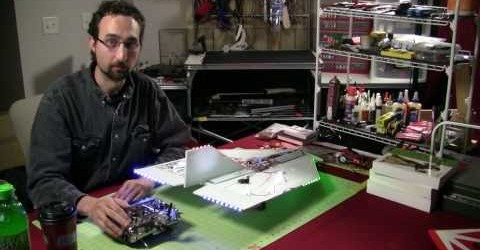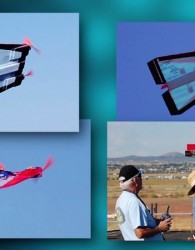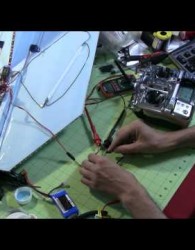Date posted: April 3, 2011
– Download Delta Wing Mixing as PDF –
Mixing, Delta Wing Style.
It’s not exactly a mixing 101 introduction, we’ll hit that topic some other day, but we do introduce the topic of mixing and how it pertains to a combat or delta wing style flyer. That is, a plane that does not have a separate aileron or elevator. They’re combined into one synchronized pair of control surfaces called ‘elevons’.
Elevon = Elevator + Aileron
When a mommy elevator and a daddy aileron reaaaaaaally like each other… No, we’re not going there. Oh, the letters I would receive.
Why do we need mixing at all? If you plug your aileron servo and elevator servo into your receiver and start banging on the stick, you’d quickly notice that only one control surface moves with elevator input and the other only moves with aileron input. Since we don’t have separate elevator and aileron control surfaces, this poses a problem.
We need to mix these transmitter inputs to multiple receiver channel outputs. That’s the quickest way to describe mixing, but not necessarily the most simplistic. Basically, we want moving the transmitter stick in one direction to actually make more than just one servo move. By default, your transmitter only moves one servo at a time if you only move a transmitter stick in one horizontal or vertical direction. Rudders move left and right, elevators move up and down, and so do ailerons.
But we need the ‘ELEVONS’ here, and we need them pronto. STAT. ASAP. There are typically three ways to perform mixing of any style, and we’ll cover two of them here. The first isn’t widely used anymore, but still fun to consider.
Mechanical Mixing
This is the one we won’t be covering in detail. But think of an aileron servo, sitting on rails, and the aileron servo connects to our two control surfaces. Now, picture an elevator servo attached to the aileron servo itself. When you give elevator movement, the control surfaces move because you’re actually MOVING the aileron servo ITSELF. When the aileron input is given, the normal servo arms move the control surfaces as you’d expect.
That’s the kind of rig you’d have to create for mechanical elevon mixing. It’s neat, and I’ve seen it done on small little combat flyers when the pilot didn’t have a programmable transmitter and the servos were embedded on a circuit board. So, not a huge amount of the population would need it. I may try and build one myself someday just to say I did. It’s how I roll here in my RC man cave.
V-Tail Adapter Mixing
So, let’s say you DO NOT have a transmitter that’s capable of mixing built in. Say the park flyer transmitters that come with popular Spektrum bind and fly kits – you know, the game controller looking transmitters. Those don’t have mixing built in for delta wing style, because they’re often attached to planes with fully separate elevators and ailerons.
So what can you do then? Pick yourself up a v-tail mixer device. They’re cheap and online and here are two examples. One here and one here.
The wiring for these is really quite simple. The hardware mixer sits between your receiver and servos. You plug your mixer into your aileron and elevator receiver channels, and the servos plug into the mixer. Voila! Instant elevon/delta wing mixing.
Programmable Transmitters
This is by far the preferred method. Most of our transmitters these days are programmable in some way, either by a PC or on the transmitter itself via switches and buttons and big old LCD screen to confuse you. However, this really is the best way to program mixing, as mechanical requires much more building setup and the v-tail mixers aren’t often as customizable as you might like.
As far as your transmitter goes, you want to look in your setup menus for options such as ‘Elevon Mixing’, ‘Delta Wing Mixing’ and the like. They’re typically under setup / adjustment / wing mix menu options. If only I had every single transmitter out there, but I don’t… so it’s hard to describe it in exact menu locations.
What is our goal with this mixing of which you speak?
The goal here is to have aileron/elevator stick movement translate into moving our elevons together in harmony. They shouldn’t be separate. We want Brad and Angelina, not Brad and Jennifer. If that reference is still applicable when you read this, I’m thankful. I would have used Burt and Loni or Ike and Tina but then I’d really be dating myself.
Quite simply though, here’s the final output checklist for your stick movements and what your control surfaces should be doing. If you’re looking at the back of the plane and the nose of the craft is facing away from you:
Moving your elevator stick DOWN (toward you)
Both control surfaces should move UP
Moving your elevator stick UP (away from you)
Both control surfaces should move DOWN
Moving your aileron stick RIGHT
the RIGHT control surface moves up, the LEFT control surface moves down
Moving your aileron stick LEFT
the LEFT control surface moves up, the RIGHT control surface moves down
No matter what mixing method you choose, if things aren’t looking like the above, you may need to reverse some servo directions on your transmitter or swap aileron/elevator servo receiver channels on your craft.
Manually mixing with your transmitter
A lot of transmitters offer ‘Programmable’ or ‘User’ mix options. These are for when the built in mixes on transmitters don’t give you what you’re looking for. Elevon mixing is SO common that I’d be surprised to see a programmable transmitter made today that doesn’t have it built in.
However, if you watch the video, we go through creating a manual mix, two of them to be exact. Why? We want the elevator stick input to also move the aileron servo (mix 1). We ALSO want the aileron stick input to move the elevator servo (mix 2). So they’re actually mixing against each other in a way.
So, a brief intro to mixing, targeted towards delta wing style flyers, like our combat flyer. Enjoy!



















2 Comments
matt
06/08/2011
excellent viedos you do a great job describing this stuff,
i have f16 enducted fan jet. i want to try out, i also just barley upgraded to a dx6. after listing to your video i think i do need to do elevon mixing, . do i need to incorperate flaps,,,, i read about flaperons but have no clue what application thats for. thanks again for your efforts.
Eric Krystof
25/08/2011
Matt,
Sorry about the late reply. Flaps vs elevon mixing all depend on the number of servos you have and what control surfaces they connect to. Can you send me a link to the item if you haven’t already solved your problem?
No trackbacks yet.